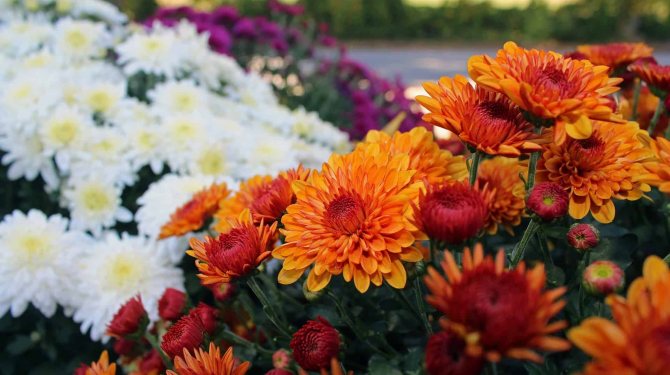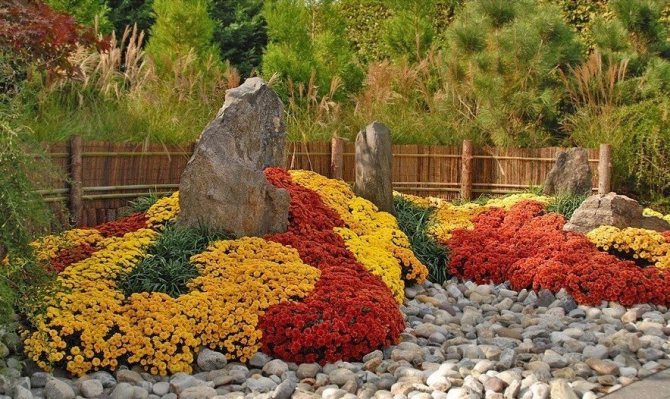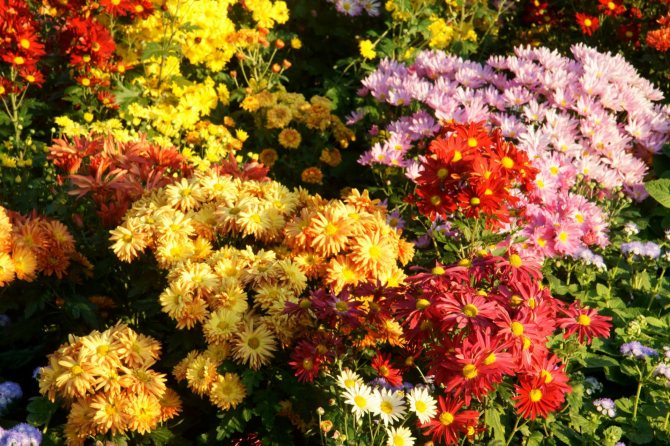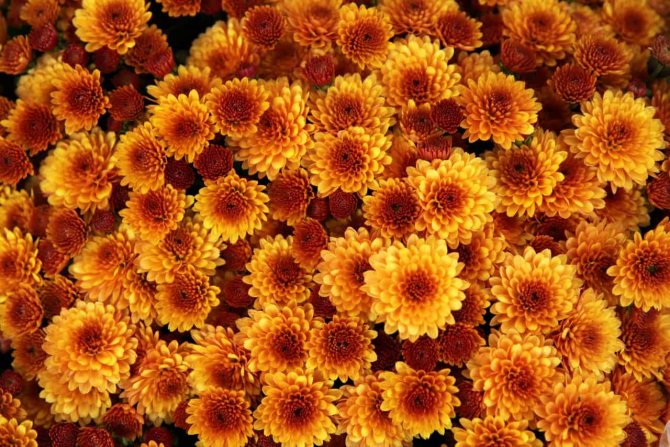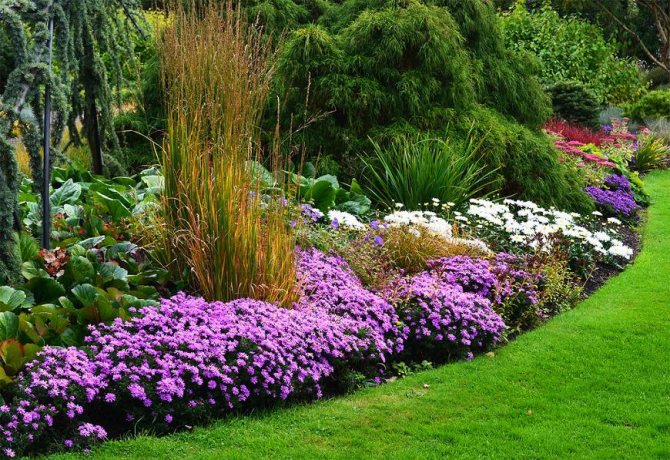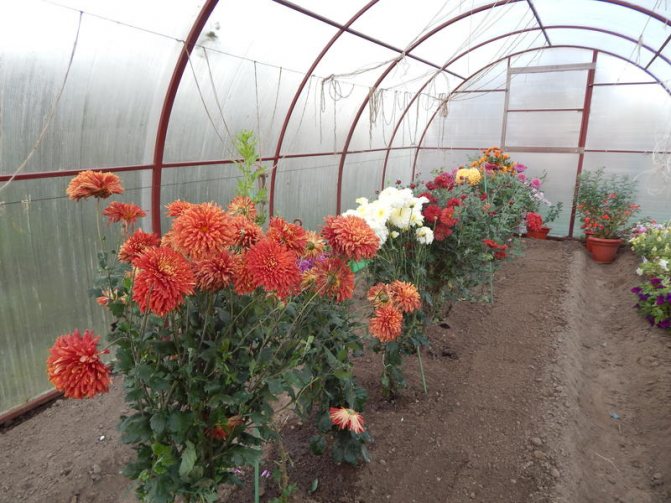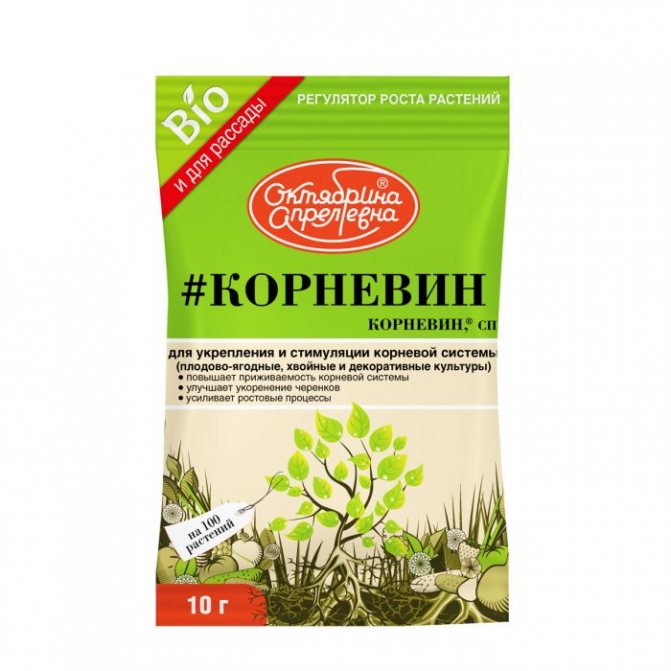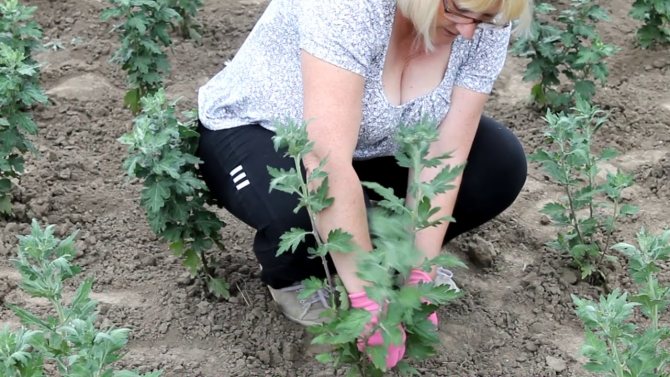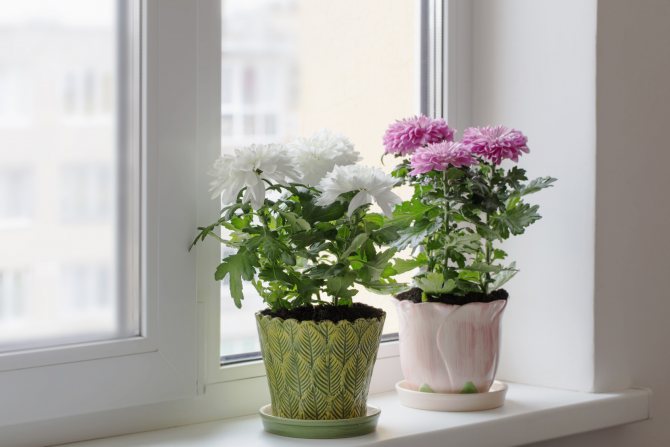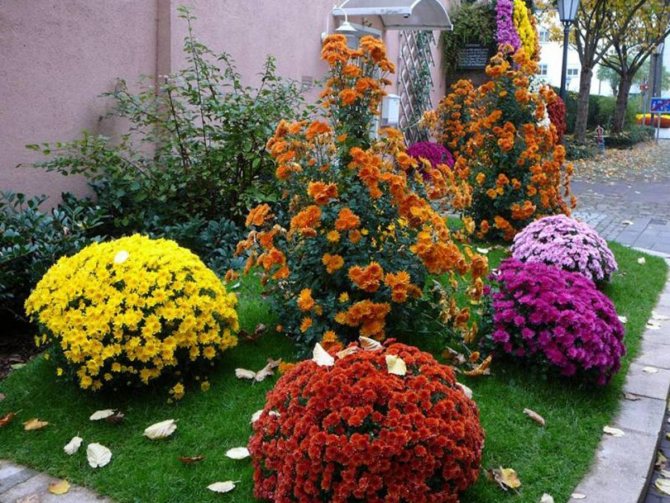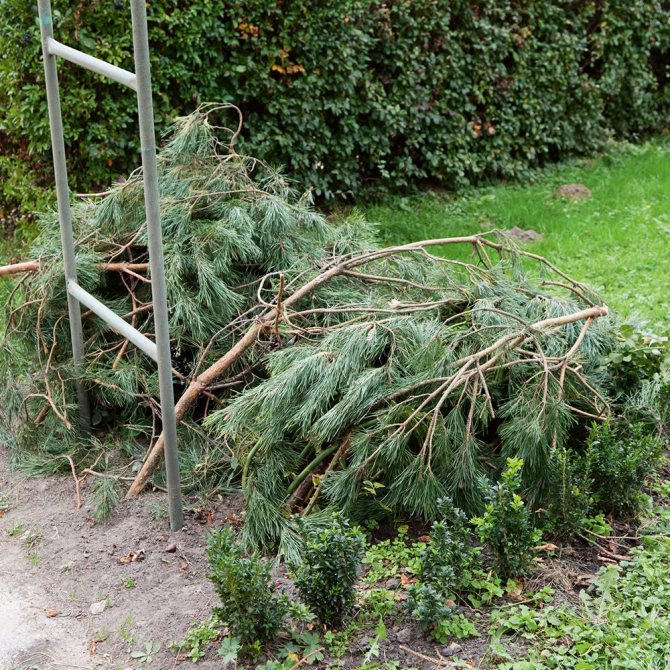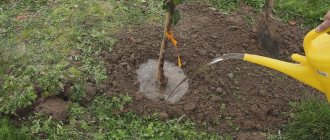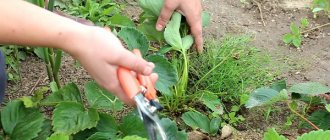Chrysanthemum in autumn, a description of the culture
Chrysanthemum is a numerous genus of plants in the Asteraceae family, which is represented by 29 species of annual and perennial chrysanthemums. In nature, most species are distributed in Asia, where they grow from the 5th century BC. e. In culture, mainly hybrids are grown, preferring northern and temperate latitudes. The distribution began in England, where the chrysanthemum got in the 8th century.
- Chrysanthemum is a herbaceous plant or low shrub, can be an annual or a perennial crop. Shoots are erect and glabrous, but can be highly branched and pubescent.
- The foliage is light green or gray-green, the arrangement of the leaves is alternate. The shape and size of the leaf is varied. The structure of the sheet is simple, solid, can be dissected, jagged edges are noticeable. Leaves can be smooth or pubescent. When rubbing the leaves between the fingers, a specific tart aroma is felt.
- Flowers of various sizes, mostly collected in large baskets. Flowers in wild species are arranged in one row, in hybrids they form a multi-row inflorescence, which creates a double effect. But in the process of selection, simple species were practically supplanted by double and semi-double hybrids. Other species have also been bred - arachnids, tubulars, pompons, etc.
- Chrysanthemums bloom in autumn. Flowering lasts from August to November, depending on the species. Duration of flowering is 1 month. The fruit is achene.
The species diversity of chrysanthemums is classified by flowering time (early, medium and late flowering) and life expectancy (annuals and perennials). For landscaping autumn gardens, perennial chrysanthemums with excellent frost-resistant properties, which appeared thanks to Korean selection, are often used. They are often referred to as "oak" for the characteristic shape of their leaves.
- Early flowering chrysanthemums bloom in the last decade of August. As a rule, these are undersized hybrids in the form of bushes. Their height does not exceed 35 cm, so they perfectly fulfill the role of curbs.
- Mid-flowering varieties bloom in September. Most varieties are medium-sized up to 60 cm in height. Mostly these are terry semi-shrubs with large buds.
- Late flowering chrysanthemums bloom in September-October and retain their decoration until frost. These are tall plants up to 1 m in height and need support.
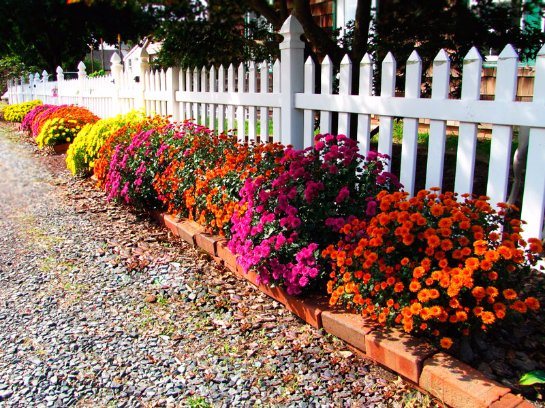
Features of planting chrysanthemums in the fall
Chrysanthemums perfectly tolerate planting in autumn, even despite the deteriorating climatic conditions. In addition, the fall planting has advantages. Firstly, you can purchase and plant an already flowering bush, knowing in advance which variety will grow. In the spring, you can get a simple look, sold as a chic hybrid.
Secondly, in the fall there is an opportunity to plant varieties with different flowering periods, having thought out the flowering of your flower garden correctly. But you also need to take into account one drawback: planting too late may prevent the bush from taking root and it will not survive the winter. To eliminate this unpleasant moment, you should plant in compliance with all the rules and provide the chrysanthemum with proper conditions.
Suitable conditions for chrysanthemums in autumn
- Active and prolonged budding of chrysanthemums is possible only in conditions of abundance of sunlight.Therefore, the site should be spacious and sunny, preferably on an elevated position. The minimum duration of open sunlight is four hours a day.
- Planted chrysanthemums in the shade will quickly stretch out, their leaves will turn pale, the flowers are crushed or will not appear at all. If increased soil moisture is added to these conditions, the plant will rot and die.
- An important factor in full bloom is the soil. You need a fertilized, moist soil, but without stagnant moisture and dampness. Poor sandy and dry peaty soil, which is not able to retain moisture, is excluded.
- The best option for chrysanthemums is sandy loam soil with a light structure, a neutral reaction. A prerequisite is the presence of drainage and plenty of organic matter.


The choice of planting material for chrysanthemums in the fall
Autumn planting material allows you to choose the most luxurious varieties. You can choose from chrysanthemums in transport pots, or plants with rhizomes covered in foil. To get a healthy plant that will survive the planting, you need to pay attention to one nuance. Young shoots should grow near the central trunk. It indicates the vitality of the bush. If not a single sprout peeps out of the ground, it is better to pay attention to another specimen, since this one is unlikely to survive the winter.
If you are going to plant chrysanthemum cuttings, you need to select the most viable ones.
- First, they shouldn't be blooming. If you choose a blooming stalk, the buds will pull out all the juices from it and after flowering it will dry out.
- Secondly, root shoots should be visible, which increase the frost resistance of the plant.
- And, thirdly, the aerial part of the cuttings should be healthy in appearance with a characteristic color of greenery, without traces of diseases. If you make a purchase through an online store, these qualities cannot be considered, so make a purchase only from trusted sellers.
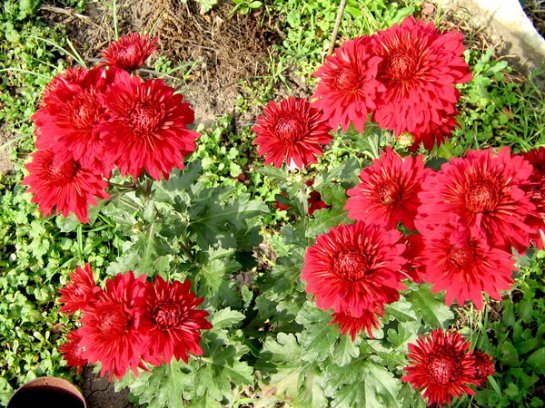

When to plant chrysanthemums in autumn
Planting chrysanthemums is permissible only in September, when the air is still warm and the soil is not too wet. If you plant a flower in October-November, the chances of rooting are minimal.
Important! Weak cuttings and bushes of chrysanthemums still have a chance to take root in the spring, but not in the fall, so only healthy and strong planting material should be used for planting.
The choice of planting material in the fall
Autumn planting material is the most convenient in the selection of varieties. At this time, flowering bushes are usually sold in pots or with a closed root system in a film. But here it is necessary to carefully study not the bush itself, but its roots. More precisely - look if there is young growth in the pot or near the central trunk, which speaks of the viability of the chrysanthemum. If not a single sprout breaks out of the peat, it is better not to buy such a plant, since the probability of successful wintering in the ground is almost zero. But there is a chance to keep the bush in the basement.
Fresh articles about garden and vegetable garden
How to store tulip bulbs until autumn
How to care for black currants?
Chrysanthemums, planting and care in the fall
The main asset of chrysanthemums is their autumn flowering, so you need to try and provide the plants with the necessary conditions. Without observing all the rules, chrysanthemums may not please you with long and rich flowering. You also need to take into account when planting that chrysanthemums should not be planted in the same place for more than three years in a row. This promises frequent diseases, pest infestations and small flowering.
Planting chrysanthemums in the fall in open ground
- Autumn planting of chrysanthemums in open ground is carried out in September.
- The planting hole is dug up to a depth of 30-40 cm. Any drainage is placed on the bottom.
- To increase fertility, a complex fertilizer is applied, but it is important not to overdo it: you do not need to apply more than 500 g, otherwise, instead of abundant flowering, you will observe the lush growth of greenery.
- If the soil is too heavy, it is prepared: peat, sand and manure (necessarily rotted) are added. Before planting, be sure to water it.
- The rhizome is slightly lowered into the hole, without deepening it too deeply, since the root system develops in the upper ball of the soil. Then the roots are sprinkled with soil, watered.
- If tall chrysanthemums are planted, they immediately build a support.
- After planting, the bushes are pinched.
- If it is hot autumn weather, the seedlings are shaded for 7 days.
- Then they carry out the necessary care: they water, weed weeds, fertilize.


Planting chrysanthemums in the fall in containers
If a stalk fell into your hands too late and it is deep October in the yard, do not despair, because it can be kept in the cellar until spring. The main thing is that the temperature in the room does not fall below + 5⁰С, and the air is not too humid. You can also plant chrysanthemum cuttings in a pot in the fall, and not in open ground. But the disadvantage of this method is that the plant will not fully rest in winter, which will have a bad effect on future flowering.
Planting a chrysanthemum in a container is easy:
- Seedlings are planted in containers with light and nutritious soil, not forgetting about drainage.
- Then they cut the bush by 2/3 in order to accelerate the acceleration and provide the chrysanthemum with winter rest.
- They are taken to the basement, where the temperature is not lower than + 5 ... + 7⁰С.
- Moderately watered and planted in a flower garden in the spring.


How to feed chrysanthemums in spring for lush flowering
The plant loves soil with an average acidity. In addition, the soil should be fertile, enriched with minerals and trace elements. To provide such a basis for the root system, it is necessary to carry out the correct feeding using the appropriate fertilizers.
How to feed chrysanthemums in spring to ensure lush flowering:
- at the time of planting, it is necessary at the very beginning to fall asleep at the bottom of the pit with humus from leaves and organic components;
- a small amount of cow dung may be an alternative. It is advisable to use dry records;
- in the spring, you need to add ammonia nitrogen in liquid form. This fertilizer option will accelerate the growth and development of the shoots. The buds will have a bright color and lush shape;
- some gardeners use multiflor complex fertilizer and other options for similar means as top dressing.
Important! When using liquid nitrogen with an ammonia component, the substance should not be allowed to hit the stem, this will lead to the appearance of burns and the death of this part.
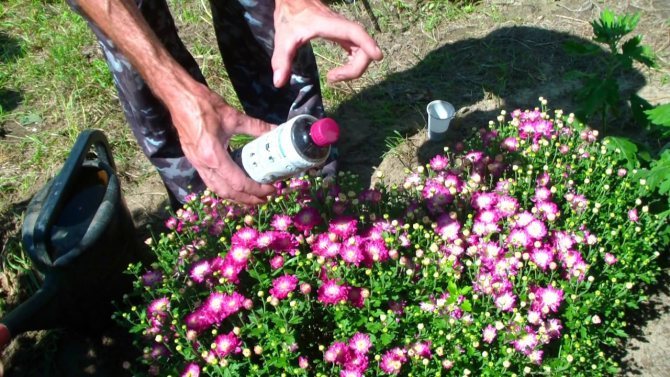

Chrysanthemum feeding
Top dressing of chrysanthemums in the spring is done only 2 times, except for the initial laying of organic fertilizers.
Chrysanthemum care in autumn
Autumn care for chrysanthemums is as follows:
- Watering. Use rainwater or well-settled water. In the fall, chrysanthemum is watered abundantly once a week, using a garden watering can without a sieve to exclude irrigation of the foliage. If the trunk circle is without mulch, weeds are removed weekly and the soil is superficially loosened. In conditions of moisture deficiency, the trunk will become lignified, and the growth of shoots will stop.
- Fertilizer. During the budding period, the bushes are fed with potassium-phosphorus fertilizer. It facilitates rooting and helps the bush to survive the winter safely. It is applied after the main watering or rain, since the rhizome of the plant is very sensitive. The frequency of feeding is every two weeks. Nitrogen fertilizers are applied in spring to stimulate crown growth, and in summer they are fed with potassium fertilizer to stimulate flowering. Chrysanthemum responds well to the introduction of a solution of chicken manure and other organic matter.
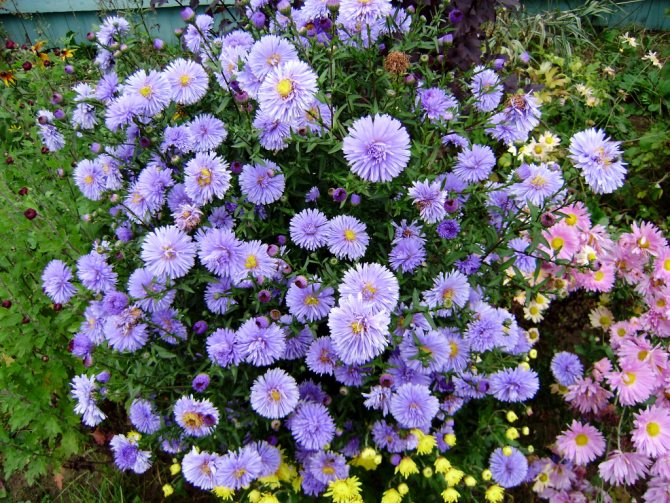

Pruning chrysanthemums in the fall
- Formative pruning of chrysanthemums is carried out only in the spring.To obtain a spherical silhouette, the upper shoot is pinched annually after 7 leaves, when the shoot grows to 15 cm in height. Side shoots are cut off at the same time. This pruning is done before bud formation begins.
- Large-flowered chrysanthemums are cut differently: only 2-3 main stems are left, which will bloom profusely. Be sure to stepchild them, tearing off new sprouts in the axils of the leaves.
- Autumn pruning is carried out for the winter. Cut off 2/3 of the crown, leaving hemp (10-15 cm). This makes it easier for the bushes to hide for the winter.


When to transplant chrysanthemums in the fall
Autumn chrysanthemum transplantation is carried out in order to strengthen the root system and increase frost resistance. It is also allowed to transplant chrysanthemums in the fall to another place when you need to redesign the flower bed. There is nothing dangerous in this process.
Flowers are transplanted right at the peak of flowering, in September. This is done only in cloudy weather, so as not to stress the plant. A prerequisite: during this period, the night air temperature should not fall below zero.
Autumn transplant
In the fall, chrysanthemums are still blooming in the garden. It is necessary to transplant flowering bushes very carefully, since the slightest damage to the roots can have a detrimental effect on them. Gardeners are still arguing about the autumn transplant of chrysanthemums. Some do not see the point in this, while others, on the contrary, argue that this is how the root system develops better and frost resistance increases.
The process of transplanting chrysanthemums in the fall is practically no different from the spring, but it has its own characteristics:
- Flower bed preparation. While digging the land, apply organic fertilizers - compost or peat. Do not overdo it with the quantity, there should be 500-600 g per 1 sq. m. Otherwise, the plant will increase the deciduous mass to the detriment of its flowering.
- Bush preparation. Trim the roots with a shovel around the plant in a radius of 20-30 cm. This promotes the formation of new roots and helps the chrysanthemum to take root in a new place faster.
- Digging a bush. Water the plant abundantly directly under the root with water and carefully dig up along with a clod of earth.
- Transfer. Since we will plant the bush with a clod of earth, the depth of the holes must be increased to 40 cm. Pour the soil with Kornevin's solution and carefully place the bush with earth in the hole, cover it with earth and tamp it with your palms.
- Water the bush liberally.
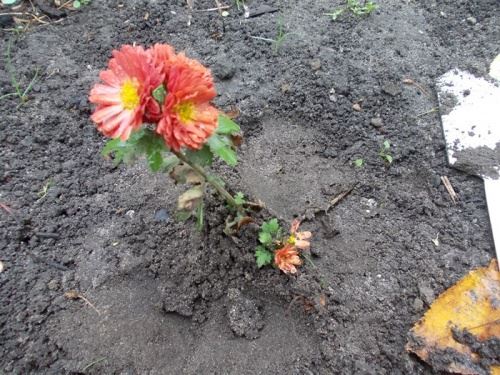

Over time, the soil around the transplanted bush may settle, so it will be necessary to fill up the soil. You also need to look after, that is, you need to water abundantly with water until the onset of frost, weed weeds and carefully loosen the top layer of the earth. In addition, you will need pruning. In small-flowered varieties, you need to pinch the tops, after which the side shoots will begin to actively grow. Thanks to this, the bush will acquire a spherical, lush shape. In large-flowered varieties, on the contrary, side shoots are removed. Before the onset of frost, mulch the soil with sawdust or straw. Also, do not forget to insulate the bushes for the winter.
Chrysanthemum transplant is not a very difficult, but responsible business. When answering the question when it is possible to transplant chrysanthemums, we will answer that this can be done both in autumn and in spring. But, of course, it is better to do this in spring - the bushes have more chances to take root and take root in a new place. If transplanted before the onset of winter, there is a risk that the flowering bushes will not have time to adapt in a new place. Do not forget that only winter-hardy varieties are subject to direct transplantation. More heat-loving chrysanthemum species need to be dug up, planted in a pot and removed to the basement.
Read also: Pepper leaves turn yellow: what to do and what to feed
Chrysanthemums in autumn, preparation for winter
Although most varieties are frost-hardy, chrysanthemums are always prepared for winter:
- In anticipation of the first frost, the bushes are cut off, leaving shoots 12-15 cm high.
- The bushes are spudded, 30-40 cm of fallen leaves are spread, and in regions with a harsh climate, chrysanthemums are additionally covered with spruce branches.
- Heat-loving varieties in the fall are transferred to pots or wooden containers. The bushes are transferred with an earthen lump and kept in a cool room with moderate lighting. Permissible air temperature + 3… + 6 ° C. The soil is moistened from time to time. In May, the bushes are transplanted into a flower garden.
Chrysanthemums that require digging for the winter include large-flowered Indian hybrids grown for cutting, such as the Golden Orpheus and Helen. They are transferred into a pot and kept indoors or transplanted into greenhouses. Globular chrysanthemums are also dug up, which can winter in the garden only in the southern regions. Korean varieties winter well without digging. These are Dubok, Camomiles, Everest, Koreyanka, Krasnaya Moscow.


Chrysanthemum bush division
Chrysanthemums reproduce very well by dividing the bush. Moreover, the bush must be divided every 2-3 years, otherwise the flowers of the thickened bush become smaller, and diseases develop more often. And one day in spring you will find that the mother bush has disappeared, and this can happen even in a not very harsh winter. On the periphery of the bush, one or several undergrowth sprouts can survive, and its center is bare. And there is only one reason for the death of the bush - there was no regular spring planting of numerous chrysanthemum shoots.
Therefore, in the spring, when the return frosts end, you need to carefully dig out the bush and free it a little from the ground.
Then, with a sharp pruner, divide the young growth, immediately plant the shoots with roots in the garden with an interval of 35x35 cm or 40x 40 cm and water. You can put it on the same place, you can put it on another, but you need to plant it a little deeper.
The soil around the plants must be well compacted, otherwise there will be strong shoot growth and weak flowering. In the first days after planting the shoots, they must be watered abundantly.
By the beginning of autumn flowering, a lush, magnificently flowering bush is formed from each such shoot.


Reproduction of chrysanthemums in autumn
Popular methods for propagating chrysanthemums in the fall are cuttings and dividing the bush.
How to propagate chrysanthemum by cuttings in the fall
- It is better to root chrysanthemum cuttings in a pot in autumn. In the open field, cuttings take root well only in the summer.
- Non-flowering cuttings are harvested from bushes of any age.
- Choose stems at least 20 cm long, and cut off the apical stalk 12-15 cm long.
- The lower leaves are removed, the upper ones are cut in half.
- The tip of the cutting is dipped in Kornevin powder.
- The soil disinfected in the oven (peat + sand or sand + sphagnum moss) is poured into the pot.
- A cutting is immersed in the soil, moisture is maintained with moderate watering. The temperature is needed at the level of + 22 ... + 24 ° С.
- Roots are formed on days 14-18.


Reproduction of chrysanthemum by dividing the bush
- Chrysanthemums can be easily propagated when transplanted in the fall.
- Chrysanthemum bushes need to be replanted every five years. At this moment, the dug out bush is divided and planted in a new place. In this case, the delenki are planted at the same depth so that they grow in the old place.
- After planting, the bushes are mulched, the first watering is carried out with a solution of Zircon.
- If the weather is hot, the bushes shade.
How to replant in spring
You can transplant the culture at the end of the winter period, after the snow has melted. In this case, the plant will have time to get stronger by winter and calmly endure the cold.
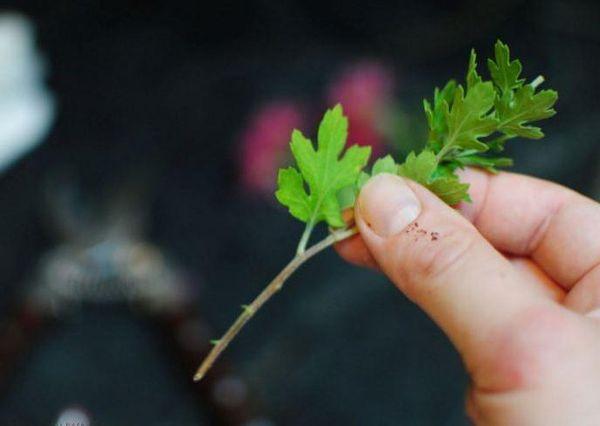

Choosing a site for a flower bed
The culture feels comfortable in flower beds that are well lit by the sun's rays. Should not be close to the groundwater surface. If they run shallow, then coarse sand is added to the holes.
Preparing bushes
The plant is carefully dug out without damaging the roots.If the soil is dry, it needs to be moistened enough to easily remove the crop.
Dividing the bush
Each sprout is separated from the uterine root with a sharp knife. Each part must have roots with shoots.
Diseases and pests of chrysanthemums in autumn
Chrysanthemums can boast of a fairly strong immune system, and only sometimes get sick. If the plant is sick, you need to know how to recognize the disease and cure it.
Fungal and viral diseases of chrysanthemums in autumn
Most often, chrysanthemum is affected by fungi. This happens if the bushes are too densely planted, grow in acidic soil, or dampness prevails. For treatment, any fungicides are used, for example, Bordeaux liquid, foundationol, colloidal sulfur.
- Septoria leaves. The plant becomes covered with yellow spots, which darken over time and resemble burns. The affected leaves are removed, sprayed with a fungicide.
- Rust. The lower part of the leaf blade is affected by a powdery orange bloom. The damaged greenery is cut off, the foundation is used, then the bushes are thinned out, and the correct watering is established.
- Fusarium wilting. The fungus affects the rhizome, which is manifested by a moisture deficit in the crown and yellowing of the leaves. The plant stops growing, there is no flowering. Affected bushes are destroyed, healthy bushes are transplanted into soil with a pH of 6.5-7.0.
- Powdery mildew. The leaves are covered with a sticky grayish coating. The cause of the disease is dampness and rainy weather. The bushes are treated with Bordeaux liquid.
- Mosaic. Affected bushes wither before our eyes, it is impossible to cure them, therefore they are destroyed.


Diseases of chrysanthemums of non-infectious nature
Any mistakes in the farming of chrysanthemums, for example, improper soil acidity, excessive watering, thickening of the planting, weaken the plant and lead to diseases.
- A big problem for flower growers is root strangulation. This state of chrysanthemum consists in waterlogging the soil and blocking air access to the roots. In such conditions, the bush turns yellow, the rhizome rots and it dies. Therefore, good drainage and looseness of the soil are prerequisites for the growth of chrysanthemums.
- Improper watering creates a lot of difficulties. Excess moisture causes root rot and deformation of the bush. Deficiency of moisture prevents the growth of shoots, the greens turn pale and wither, the bush begins to ache.
- Unbalanced organic feeding is very harmful to chrysanthemums. So, manure can burn the rhizome or weaken the plant. Therefore, feeding is carried out in moderation and only after abundant watering.
Chrysanthemum pests
Chrysanthemums can be damaged by various insects, so keep insecticides ready.
- Leaf nematode. It often hibernates on uncleared remains of aerial shoots of many plants and easily damages chrysanthemums. The problem manifests itself with yellow-brown spots. The foliage begins to fade, dies off. Without treatment, the bush dies. If a nematode has just appeared on a chrysanthemum, you can try to treat it with an insecticide. With a strong defeat, the diseased bush together with the rhizome are destroyed. The rest of the plants mulch, and during watering they do not allow sprinkling of the leaves.
- Aphid. Pests drain buds and leaves by drinking their juice. To destroy them, use Aktellik or Karate, you can treat the bush with a solution of copper sulfate and washing soap.
- Spider mite. Leads to falling leaves, wilting of the bush. It reproduces especially intensively in hot weather. Spraying with infusion of garlic and dope helps well.
Nice place for flowers
It is important to plant a chrysanthemum in the fall in a place where it could take root in the shortest possible time. In the case of this flower, this is a dry, sunny place. Chrysanthemums do not tolerate shade and a lot of moisture, so it is better to plant them on some elevation. As a rule, in such places there is no thick shade, and a small breeze blows through the ground, which removes excess moisture.


We plant chrysanthemums in the fall in loose soil that allows moisture and air to pass through well. This will provide the plant with rapid growth and abundant flowering. Do not forget about the nutritional value of the soil. The more organic matter and minerals it contains, the better. If the soil in your garden is not at all like that, then you can improve its qualities yourself. To do this, season the soil with rotted manure, add peat or compost to it. You can also mix the soil in which you will plant the flower with sand. This will improve its drainage properties.

